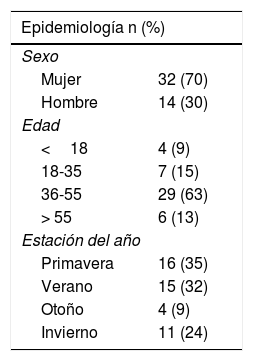La infección por parvovirus B19 (PVB19) tiene una incidencia elevada y distribución mundial. Su espectro clínico es amplio, destacando las manifestaciones cutáneas, articulares y hematológicas. El objetivo del presente estudio fue estudiar epidemiología y manifestaciones clínico-analíticas de la primoinfección por PVB19.
Pacientes y métodoEstudio retrospectivo (10 años) de pacientes con serología IgM positiva para PVB19. Se incluyeron 46 pacientes y se estudiaron sus características demográficas, clínicas y analíticas.
ResultadosLa primoinfección fue más prevalente en mujeres (ratio 2,2:1), y en edad media de 41años. La afectación articular fue la más frecuente (65%). En más de la mitad de los pacientes (24 casos) se observaron alteraciones cutáneas: exantema (28%), megaloeritema (9%), afectación «en guantes y calcetines» (6,5%), afectación periflexural (4%) y edema (4%). De entre las alteraciones hematológicas destacó la anemia (35%). El cuadro clínico se autolimitó en 1-2 semanas en la mayoría de los pacientes.
ConclusionesA pesar de que existe un espectro clínico variable, las poliartralgias y el exantema maculopapular generalizado junto con fiebre y anemia son las manifestaciones típicas y más frecuentes de la primoinfección por PVB19 y suelen autolimitarse.
Parvovirus B19 (PVB19) infection has a high incidence and worldwide distribution. It has a broad clinical spectrum, with skin, joint and haematological manifestations being the most common. The objective of this study was to determine the epidemiology and clinical-analytical manifestations of acute PVB19 infection.
Patients and methodsA retrospective study of patients with a positive IgM serology for PVB19 (10 years). Forty-six patients were included and their demographic, clinical and analytical characteristics were analyzed.
ResultsPrimary infection was most prevalent in women (ratio 2.2:1) aged 41 (mean age). Joint involvement was the most common manifestation (65%). Skin abnormalities were observed in more than half of patients (24 cases): rash (28%), megalerythema (9%), “gloves and socks” involvement (6.5%), periflexural rash (4%) and oedema (4%). Anaemia was the main haematological alteration (35%). The symptoms were self-limiting and resolved in 1-2 weeks in most patients.
ConclusionsAlthough there is a variable clinical spectrum, polyarthralgias and generalized maculopapular rash with fever and anaemia are the typical and most frequent manifestations of primary infection by PVB19 and are usually self-limiting.
Artículo
Comprando el artículo el PDF del mismo podrá ser descargado
Precio 19,34 €
Comprar ahora








